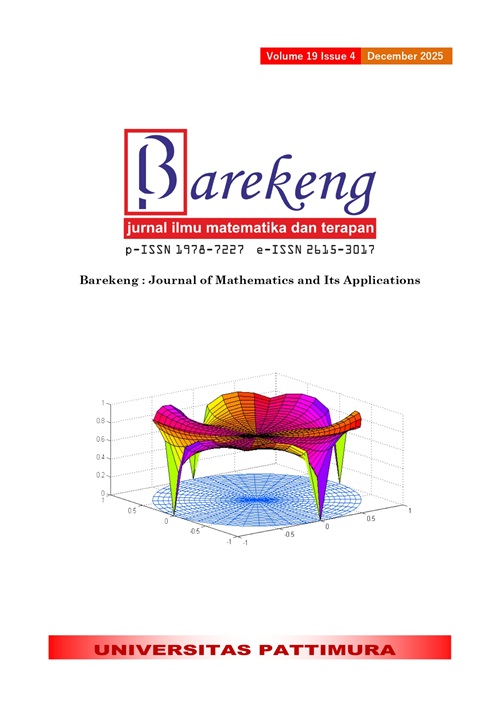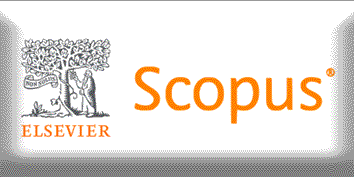APPLICATION OF BACKPROPAGATION FOR FORECASTING OPEN UNEMPLOYMENT IN MAKASSAR CITY
Abstract
Based on data from the Statistics Bureau of South Sulawesi Province, the open unemployment rate in Makassar City has remained consistently high over the past ten years, averaging 11.41%. This highlights a persistent labor market issue and positions Makassar as the leading contributor to the open unemployment rate in the province. To support effective policymaking and early intervention strategies, it is essential to forecast future unemployment trends based on historical data. Therefore, this study aims to forecast the open unemployment rate in Makassar City over the next five years using a machine learning approach. Among the available forecasting methods, the Backpropagation Artificial Neural Network (ANN) was selected due to its proven ability to model complex, non-linear relationships often found in socio-economic data. ANN is particularly effective in handling temporal dynamics without assuming linearity or stationarity, unlike traditional statistical models. In this study, the forecasting process involved data normalization, scenario-based data partitioning, ANN architecture design, and model training and testing. The model with the best performance consisted of 11 neurons in the input layer, 55 neurons in the hidden layer, and 1 neuron in the output layer, using 80% of the data for training and 20% for testing. This configuration yielded a forecasting accuracy of 91.896%, with a MAPE of 8.131% and an MSE of 0.003. The denormalized results forecast a steady decline in the open unemployment rate from 9.078% in 2023 to 7.248% in 2027, indicating a positive trend in employment. Nevertheless, it is important to acknowledge the limitations of forecasting models and the potential influence of external factors that may affect actual outcomes.
Downloads
References
A. R. D. Prayitno and D. Kusumawardani, “OPEN UNEMPLOYMENT RATE IN THE PROVINCE OF EAST JAVA,” The Winners, vol. 23, no. 1, pp. 11–18, 2022, doi: https://doi.org/10.21512/tw.v23i1.7047.
Y. A. Lesnussa and E. Risamasu, “APLIKASI JARINGAN SYARAF TIRUAN BACKPROPAGATION UNTUK MERAMALKAN TINGKAT PENGANGGURAN TERBUKA (TPT) DI PROVINSI MALUKU,” Sainmatika J. Ilm. Mat. dan Ilmu Pengetah. Alam, vol. 17, no. 2, p. 89, 2020, doi: https://doi.org/10.31851/sainmatika.v17i2.3434.
BPS, “TENAGA KERJA.” [Online]. Available: https://www.bps.go.id/subject/6/tenaga-kerja.html#:~:text=TPT (Tingkat Pengangguran Terbuka) adalah,kurang dari 35 jam seminggu) [access on May, 2023].
Richard Frimpong Oppong and Weihuan Zhou, “THE INFLUENCE OF INFLATION ON THE UNEMPLOYMENT RATE OPEN IN MEDICAL FIELD OF UNITED STATES IN 2018,” MEDALION J. Med. Res. Nursing, Heal. Midwife Particip., vol. 2, no. 4, pp. 130–144, 2021, doi: https://doi.org/10.59733/medalion.v2i4.38.
BPS, “TINGKAT PENGAGGURAN TERBUKA PROVINSI SULAWESI SELATAN.” [Online]. Available: https://sulsel.bps.go.id/indicator/6/466/1/tingkat-pengangguran-terbuka.html [access on May, 2023].
C. Dewi and H. W. Wilubertha, “PREDIKSI TINGKAT PENGANGGURAN MENGGUNAKAN ADAPTIF NEURO FUZZY INFERENCE SYSTEM ( ANFIS ),” Konf. Nas. Sist. Inform. 2015, vol. 2015, no. 2004, pp. 9–10, 2015.
M. F. Almas, B. D. Setiawan, and Sutrisno, “IMPLEMENTASI METODE BACKPROPAGATION UNTUK PREDIKSI HARGA BATU BARA,” J. Pengemb. Teknol. Inf. dan Ilmu Komput., vol. 2, no. 12, pp. 6502–6511, 2018, doi: 10.33330/jurteksi.v4i2.40.
P. Kumar, F. Almeida, B. Nagaraja, A. R. Ajaykumar, and Q. Al-Mdallal, “NEURAL NETWORK MODEL USING LEVENBERG MARQUARDT BACKPROPAGATION ALGORITHM FOR THE PRANDTL FLUID FLOW OVER STRATIFIED CURVED SHEET,” IEEE Access, vol. 12, no. May, pp. 102242–102260, 2024, doi: https://doi.org/10.1109/ACCESS.2024.3422099.
A. Sudarsono, “JARINGAN SYARAF TIRUAN UNTUK MEMPREDIKSI LAJU PERTUMBUHAN PENDUDUK MENGGUNAKAN METODE BACPROPAGATION (STUDI KASUS DI KOTA BENGKULU),” J. Media Infotama, vol. 12, no. 1, pp. 61–69, 2016, doi: https://doi.org/10.37676/jmi.v12i1.273.
M. Güler et al., “FORECASTING OF THE UNEMPLOYMENT RATE IN TURKEY: COMPARISON OF THE MACHINE LEARNING MODELS,” Sustain., vol. 16, no. 15, pp. 1–17, 2024, doi: https://doi.org/10.3390/su16156509.
M. F. Andrijasa and Mistianingsih, “PENERAPAN JARINGAN SYARAF TIRUAN UNTUK MEMPREDIKSI JUMLAH PENGANGGURAN DI PROVINSI KALIMANTAN TIMUR DENGAN MENGGUNAKAN ALGORITMA PEMBELAJARAN BACKPROPAGATION,” J. Inform. Mulawarman, vol. 5, no. 1, 2010.
Q. K. Al-Shayea, “ARTIFICIAL NEURAL NETWORKS IN MEDICAL DIAGNOSIS,” IJCSI Int. J. Comput. Sci. Issues, vol. 8, no. 2, pp. 150–154, 2011, doi: 10.2478/v10136-012-0031-x.
M. W. Talakua, V. Y. I. Ilwaru, B. P. Tomasouw, and S. Z. Limba, “INFLATION FORECASTS IN AMBON USING NEURAL NETWORK APPLICATIONS BACKPROPAGATION,” BAREKENG J. Ilmu Mat. dan Terap., vol. 16, no. 2, pp. 483–496, 2022, doi: https://doi.org/10.30598/barekengvol16iss2pp483-496
M. Agustin and T. Prahasto, “PENGGUNAAN JARINGAN SYARAF TIRUAN BACKPROPAGATION UNTUK SELEKSI PENERIMAAN MAHASISWA BARU PADA JURUSAN TEKNIK KOMPUTER DI POLITEKNIK NEGERI SRIWIJAYA,” J. Sist. Inf. Bisnis, vol. 02, pp. 89–97, 2012.doi: https://doi.org/10.21456/vol2iss2pp089-097
A. Revi, S. Solikhun, and M. Safii, “JARINGAN SYARAF TIRUAN DALAM MEMPREDIKSI JUMLAH PRODUKSI DAGING SAPI BERDASARKAN PROVINSI,” KOMIK (Konferensi Nas. Teknol. Inf. dan Komputer), vol. 2, no. 1, pp. 297–304, 2018, doi: https://doi.org/10.30865/komik.v2i1.941.
F. Timorremboko and O. T. Karya, “IMPLEMENTASI JARINGAN SYARAF TIRUAN PADA KENDALI LAMPU SOROT MOBIL ADAPTIF BERBASIS PYTHON,” J. Teknol. Elektro, vol. 11, no. 3, pp. 142–147, 2020, doi: https://doi.org/10.22441/jte.2020.v11i3.006.
I. N. da Silva, D. H. Spatti, R. A. Flauzino, L. H. B. Liboni, and S. F. dos R. Alves, ARTIFICIAL NEURAL NETWORKS, vol. 50, no. 2. Switzerland: Springer International Publishing Switzerland, 2017. doi: https://doi.org/10.1007/978-3-319-43162-8.
Julpan, E. B. Nababan, and M. Zarlis, “ANALISIS FUNGSI AKTIVASI SIGMOID BINER DAN SIGMOID BIPOLAR DALAM ALGORITMA BACKPROPAGATION PADA PREDIKSI KEMAMPUAN SISWA,” J. Teknovasi, vol. 02, pp. 103–116, 2015.
Sugiarto, “PENERAPAN JARINGAN SYARAF TIRUAN METODE RADIAL BASIS FUNCTION (RBF) UNTUK PREDIKSI PENJUALAN KERIPIK NENAS,” UIN SUSKA RIAU, 2019.
F. Zola, G. W. Nurcahyo, and J. Santony, “JARINGAN SYARAF TIRUAN MENGGUNAKAN ALGORITMA BACKPROPAGATION UNTUK MEMPREDIKSI PRESTASI SISWA,” J. Teknol. Dan Open Source, vol. 1, no. 1, pp. 58–72, 2018, doi: https://doi.org/10.36378/jtos.v1i1.12.
A. Andrian, “PENERAPAN ALGORITMA BACKPROPAGATION DAN PRINCIPAL COMPONENT ANALYSIS UNTUK PENGENALAN WAJAH,” Teknovasi, vol. 1, no. 2, pp. 62–70, 2014.
A. A. Fadila M, “APLIKASI JARINGAN SYARAF TIRUAN DALAM MEMPEDIKSI PENJUALAN MOBIL PADA PT.HADJI KALLA SENGKANG,” Universitas Islam Negeri (UIN) Alauddin Makassar, 2017.
D. Jauhari, Al. Hinawan, and D. Candra, “PREDIKSI DISTRIBUSI AIR PDAM MENGGUNAKAN METODE JARINGAN SYARAF TIRUAN BACKPROPAGATION DI PDAM KOTA MALANG,” J. Teknol. Inf. dan Ilmu Komput., vol. 3, no. 2, pp. 83–87, 2016.doi: https://doi.org/10.25126/jtiik.201632155
K. Kingphai and Y. Moshfeghi, “ON TIME SERIES CROSS-VALIDATION FOR MENTAL WORKLOAD CLASSIFICATION FROM EEG SIGNALS,” … 3Rd …, pp. 1–3, 2021, [Online]. Available: https://neuroergonomicsconference.um.ifi.lmu.de/wp-content/uploads/submissions/207.pdf
J. Wahyuni, Y. W. Paranthy, and A. Wanto, “ANALISIS JARINGAN SARAF DALAM ESTIMASI TINGKAT PENGANGGURAN TERBUKA PENDUDUK SUMATERA UTARA,” J. Infomedia, vol. 3, no. 1, 2018, doi: https://doi.org/10.30811/jim.v3i1.624.
Copyright (c) 2025 Rahmat Syam, Sahlan Sidjara, Adib Roisilmi Abdullah

This work is licensed under a Creative Commons Attribution-ShareAlike 4.0 International License.
Authors who publish with this Journal agree to the following terms:
- Author retain copyright and grant the journal right of first publication with the work simultaneously licensed under a creative commons attribution license that allow others to share the work within an acknowledgement of the work’s authorship and initial publication of this journal.
- Authors are able to enter into separate, additional contractual arrangement for the non-exclusive distribution of the journal’s published version of the work (e.g. acknowledgement of its initial publication in this journal).
- Authors are permitted and encouraged to post their work online (e.g. in institutional repositories or on their websites) prior to and during the submission process, as it can lead to productive exchanges, as well as earlier and greater citation of published works.






1.gif)



